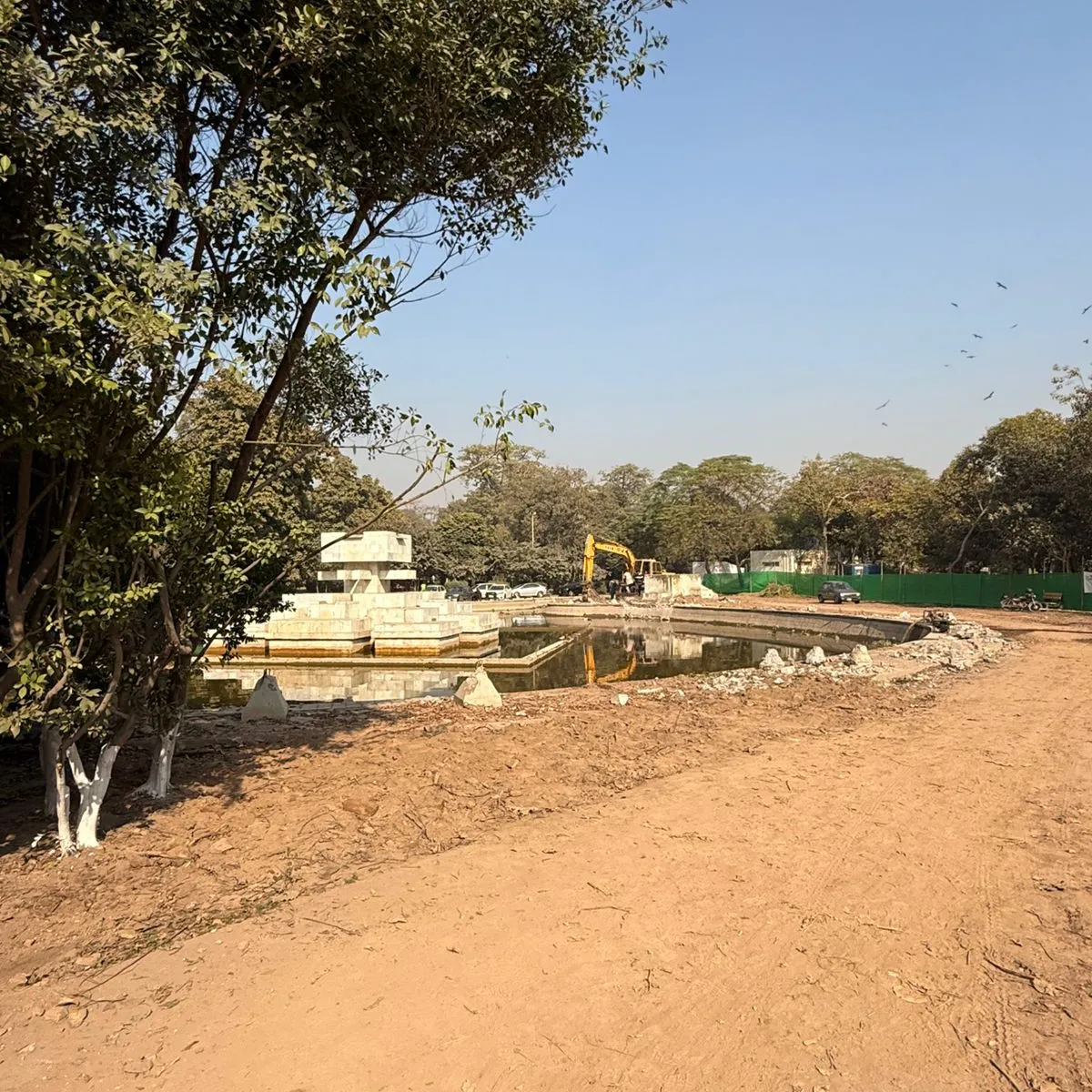Irrigating deserts for agriculture is in. So is uprooting fertile farmlands. It may seem contradictory, but it’s a reality in our part of the world.
Such confused state priorities have left many scratching their heads, grappling with the logic of greening barren land for farming in Cholistan under the Green Pakistan Initiative while burying fertile fields with steel and concrete to make way for the Ravi Urban Development Project in the outskirts of Lahore. Punjab is becoming a land of great paradox.
Punjab Chief Minister Maryam Nawaz climbed aboard a tractor to launch the Green Pakistan Initiative (GPI) on February 15, aiming to transform thousands of acres of Cholistan desert in South Punjab into fertile farmland, through newly-constructed canals that are planned to draw water from the Sulemanki Headworks on the Sutlej River. Dressed in green — perhaps to emphasise the project's ‘greenness’ — she championed the initiative as beginning of a new phase in corporate agriculture.
Meanwhile in Lahore, the heart of her power base, a real estate developer has dotted the cityscape with billboards, featuring a former cricketing star, promoting a private housing society as part of the Ravi Urban Development Authority (RUDA) scheme. RUDA is a riverfront real estate development along River Ravi, stretching over 140,000 acres of land, out of which some 78000 acres is farmland, purported to meet the demands of 12.5 million people. The scheme is scheduled to be completed by 2050.
“Farming in the Cholistan desert makes sense only with additional water availability which currently is not the case,” says Malik Amin Aslam, who was minister for environment from 2002-2007, and an adviser on climate change to the prime minister from 2018-2022. “The only way to make it a feasible venture for food security is to capture the floodwater deluge which gets wasted in Pakistan.”
For him, the more urgent priority would have been to stop the ravaging of fertile agricultural lands, like in the case of RUDA, “by unregulated and uncontrolled expansion of housing societies around urban areas in Punjab”.
Inaugurated by former Prime Minister Imran Khan in August 2020, the RUDA was established to transform designated areas with modern amenities and high environmental standards, and to revive the River Ravi by recharging its aquifer.
The scheme however sparked concerns among critics – urban planners, environmentalists, and lawyers – who argue that it is ill-planned and environmentally harmful – and feeds the greed of real estate developers. They contend that if it provides grains, vegetables and fruit to the people of the area, why uproot it and expand urban sprawl before giving Lahore a chance to grow vertically.

The city of the future?
For an unsuspecting property buyer, the RUDA is a charming investment proposition – after all, the authority’s website shows smart building plans and promises a golf course, upscale entertainment centres, education sector, farmers' market, and housing (including low-cost housing). It boasts flood protection and innovative climate change solutions, offers state of the art sanitation, green spaces, and a healthier and cleaner Ravi.
But a closer look reveals these are mere buzzwords to attract investors rather than concrete urban development strategies. Malik Amin Aslam says the land mafia is sensing a bonanza around one of the most densely populated urban centres in Punjab, “while ecological concerns are either dangerously ignored or pushed under the rug.”
Urban developers have expressed concerns about how the RUDA will integrate with the rest of Lahore. Currently, transport connections to the demarcated RUDA area rely primarily on roads, using the existing highway and arterial network. There is no indication yet that Lahore’s current or planned public transport and rail infrastructure will extend to the new RUDA development. Initially, “the Lahore Ring Road, Ferozepur Road, M2 and M11 motorways, and the Lahore–Gujranwala GT Road are likely to serve as the main arteries,” says Sheikh. In the future, he adds, “Multan Road, Canal Road, and the Lahore–Multan GT Road are expected to carry most of the traffic load for RUDA.”
Although a rail line runs through the RUDA-designated area, he explains, it remains unclear whether a major rail station will be developed to provide high-capacity transit access. “Based on current information, it appears that the RUDA’s planning leans toward road-based travel, a car-centric approach.”
New life for Ravi?
On a mid-February spring day, the sun shone brightly against Lahore’s rarely seen clear blue sky. On the ground, however, dust clouds blew across the landscape. The sprouting wheat crop and bright yellow mustard flowers offered no resistance, swaying gently. A makeshift construction site office occupied a patch of land, next to farm fields, as trucks and tractors rumbled on like cannons, as if set to overtake the surrounding calm with turbulence.

Farther on, the green and yellow fade, give way to a concrete slope and a depressed ground stretching to the horizon – indicating that the channelling of Ravi is underway.
This under-construction River Ravi Training and Channelisation Project is a sub-project of the Ravi Riverfront Urban Development Project. The 46-kilometre-long channel, between Syphon and Mohlawan, is planned to be one-kilometre-wide and 20-foot-deep. It will feature a mix of four barrages and dams, and will hold 176 billion litres of water that will “recharge the aquifer at a rate of 500 cusecs per day,” informs Col Abid Latif, representing the RUDA.
Presently, work on six kilometres of the total 46 kilometres is complete. The entire project is slotted for completion in eight years, with the first phase concluding by 2027.
He explains that the plan to channelise the Ravi is “a bold hydrological project designed to maintain riparian neutrality. It aims to tame floodwaters by building structures capable of withstanding up to 586,000 cusecs — a benchmark informed by a thousand years of return-period data”.
Once complete, “Rainfall and monsoon runoff will feed this water body,” he continues, “bolstered by an additional 1,000 cusecs from the Bambawali-Ravi-Bedian (BRB) canal and another 1,000 cusecs sourced from water treatment plants. Inlets and artificial aeration will keep dissolved oxygen levels high, ensuring that aquatic life can thrive.”
Experts, however, remain sceptical about the promises of the Ravi makeover. Malik Amin Aslam say:, “The entire concept of RUDA is pivoted around the flawed taming of the Ravi with upstream barrages and the dredging and lining of the river around Lahore.” He adds: “What’s happening is urban expansion into the floodplain without putting proper control mechanisms in place.”
Instead, he explains, “a better option would be to establish a Ravi-protected wetland area with urban development on its peripheries. That model would have benefited development while also restoring and safeguarding the river’s ecology.”
Concerns have been repeatedly raised about the ongoing plan. The Asian Development Bank (ADB) financed a three-year study called the ‘Ravi River Basin Eco-Revitalization Master Plan’ in 2018, with its final report presented to the Punjab Planning & Development department in 2021. The study proposed a balanced approach to restoring the heavily polluted river, including designating parts of the riverbed and floodplain as national parks to facilitate ecological revitalisation.
In contrast to the ADB-backed recommendations, the RUDA decided to pursue the channelisation of the river, supposedly to open the entire floodplain for urban real estate projects. “It's just greedy. It’s a terrible idea,” says Ahmed Rafay Alam, a lawyer and environmentalist.
Momin Sheikh, an urban development expert based in Lahore, points out that channelising the Ravi will raise its water level by narrowing the river’s width and effectively creating a canal. “Flood warnings for the Ravi are almost an annual or biannual occurrence,” he says, noting that the risk intensifies during the monsoon, when India opens floodgates after its reservoirs fill. With the proposed channelisation, he adds, “new developments along the riverbank would be at greater risk in the event of a flood, unlike the current scenario where only a few scattered settlements occupy the floodplain.”
Latif also claims that the drainage and sewage carrying toxic water will be treated through six wastewater treatment plants before it enters the Ravi. Dr Hassan Abbas believes the claim is misleading, because the Ravi has little to no natural water flow, relying instead on link canals that primarily serve agricultural land. However, much of this water is heavily polluted due to wastewater discharge, our own as well as that from across the border. The Hudiara Drain, which originates in the Indian Punjab, enters Pakistan, and passes along Raiwind, a suburb of Lahore, before merging into the Ravi. This drain carries highly toxic sewage into the river. “Under the Indus Water Treaty, Pakistan is required to accommodate this waste, even if it means expanding the drain’s width. How will RUDA’s Ravi channelling project overcome this problem?” he questions.

Legal battles over land acquisition
Besides the dreamy vision of a new city and the revitalisation of the Ravi, the RUDA has been mired in legal disputes over land acquisition.
A writ petition before the Lahore High Court (LHC) was filed by the Public Interest Law Association of Pakistan (PILAP), a not-for-profit initiative, and many other aggrieved parties whose land was subject to acquisition (about 4,559 acres of land had been acquired up to the time of filing of writ petition). The court declared on December 25, 2021 that in the absence of an independent master plan and agreement with local government, any scheme is unlawful and illegal and that no acquisition of agricultural and cultivable farmland can be done. The court also stressed on rigorous environmental clearances through an Environmental Impact Assessment (EIA) and approval from the Environmental Protection Agency (EPA).
Next, an appeal was filed by the Punjab government against the decision of the LHC in the Supreme Court. The SC on January 31, 2022 granted the Punjab government leave to appeal the LHC judgment; it suspended interim relief by the LHC’s judgment; and allowed the RUDA and its allied agencies to continue work — but only on lands that had already been acquired and taken possession of and for which compensation had been awarded or released.
Ahmed Rafay Alam, who represented PILAP in the court, adds that the SC order was passed in interesting circumstances. “I learnt the government had filed an appeal against the LHC judgment in the SC on a Friday night from a tweet on social media. The appeal was fixed for its first, and only hearing, on the coming Monday – and so we scrambled to get to the court. Normally appeals in the SC are not entertained unless the respondent party has been given formal notice of an appeal. We received no such formal notice and the appeal was fixed before a two-member bench of the Supreme Court without even a diary number.”
Later, in 2022, the RUDA tried to act on land acquisition notices it had issued before the LHC judgment. Locals again approached the LHC in a second round of litigation where the LHC stayed any further action on acquisition by the RUDA on those land acquisition notifications. “The cases have not come up for hearing in the courts since they were filed in late 2022-early 2023…. Not even once,” says Alam.
Latif, however, says, “There is a general misnomer that RUDA is still acquiring land through land act and its award. Fact is that RUDA is getting land through open source market mechanism. Very limited cases are in courts of law with mundane and varied litigations. 156 cases are already solved in favour of RUDA. No litigation is affecting RUDA's development or construction activity.”
In another turn, perhaps constrained by the LHC’s order while pursuing farmland for the development, the authority pushed for amendments to the Ravi Urban Development Act 2020 in the Punjab Assembly. The amendments resulted in the updated law called Ravi Urban Development Authority (Amendment) Act 2022, which was retrospective and gave legal cover to the RUDA’s earlier activities. “About 50 amendments are insertions and replacement of words to enhance, clarify and delineate the operational efficacy of the authority,” says Col Abid Latif.
Thereafter, the RUDA commenced buying land through middlemen or by entering into ‘partnerships’ with property owners within the RUDA limits. By doing so, says Alam, “RUDA thinks it can get around the prohibition [in the SC Interim Order] that it can’t acquire any more land.”
Experts view the new law as a worrisome expansion of power – as it removes the requirement that the RUDA prepare a master plan and get the consent of local governments. The amendments are basically “an attempt to undo [previous] mistakes made by the RUDA,” says Alam.
The amended act was “hurriedly passed to give a legal cover to the land grab and has also possibly created the grounds for a looming ecological catastrophe with urban expansion in a floodplain,” says Malik Amin Aslam.
Think, pause, rethink
The RUDA’s idea isn't unprecedented. Similar initiatives are taking shape in Bhutan and Indonesia.
The cheerful Himalayan kingdom of Bhutan, home to less than 800,000 people with 85 percent of its land covered in forest but fraught by migration of its youth due to lack of job opportunities, is set to build a new city – Gelephu Mindfulness City (GMC). It is envisioned to be an economic corridor linking South Asia to Southeast Asia. An international airport and regional rail network will connect the city to global markets.
The GMC is said to become a blueprint for future cities – and it is backed by its people proud of its Gross Happiness Index, which measures factors ignored by gross domestic product (GDP), such as recreation, emotional wellbeing and environment.
In Indonesia’s Jakarta, a new capital city has been conceived – to challenge overcrowding, severe traffic congestion, chronic flooding, pollution, and rising sea levels that are threatening to sink Jakarta. Named Nusantara, it is being constructed within the jungles of East Kalimantan on Borneo, an island shared with Malaysia.
Nusantara is envisioned as a hub of Indonesia’s expanding economic and geopolitical influence, establishing a capital distinct from Jakarta’s colonial-era government legacy.
If GMC represents the blueprint for modern, sustainable development, the RUDA’s plan stands in contrast with emphasis on concrete expansion. If Nasuntara is aimed to relieve Jakarta of the over grown population and serve as a centre for administrative and economic activities, once again the RUDA offers more of the same old Lahore. Both Gelephu and Nasuntara may have overly ambitious vision, but at least both are committed to the future. The RUDA appears to lack any enduring outlook. The RUDA needs an urgent rethink.
Meanwhile, it's a wait and see game for those fighting for their land.

All images courtesy of the author.





